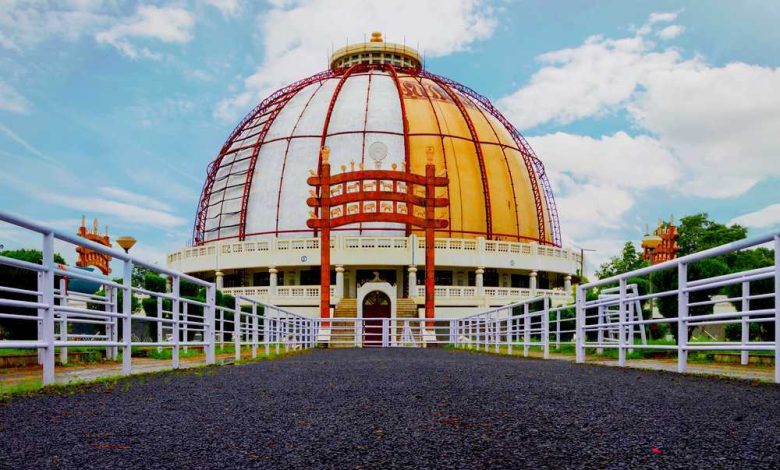Unveiling the Enchanting Charms of Nagpur, Maharashtra

-
Table of Contents
- Introduction
- Exploring the Rich Heritage of Nagpur, Maharashtra
- Top Attractions to Visit in Nagpur, Maharashtra
- Unveiling the Cultural Delights of Nagpur, Maharashtra
- Discovering the Gastronomic Delights of Nagpur, Maharashtra
- Nagpur, Maharashtra: A Haven for Nature Enthusiasts
- The Historical Significance of Nagpur, Maharashtra
- Experiencing the Festivals and Events of Nagpur, Maharashtra
“Nagpur (Orange City) Maharashtra: Where Tradition Meets Progress”
Introduction
Nagpur (Orange City) is a city located in the state of Maharashtra, India. It is the third largest city in Maharashtra and the 13th largest city in India. Known as the “Orange City” due to its major production of oranges, Nagpur is also a major commercial and political center in the region. The city has a rich history, with evidence of human settlements dating back to the 8th century. Nagpur is known for its vibrant culture, historical landmarks, and educational institutions. It is also an important transportation hub, with well-connected road, rail, and air networks.
Exploring the Rich Heritage of Nagpur, Maharashtra
Nagpur, located in the state of Maharashtra, is a city that is steeped in history and rich in heritage. From its ancient temples to its magnificent forts, Nagpur offers a glimpse into the past and a chance to explore the cultural heritage of Maharashtra.
One of the most iconic landmarks in Nagpur is the Deekshabhoomi, a sacred Buddhist monument. This grand structure is a symbol of the conversion of Dr. B.R. Ambedkar to Buddhism and is a place of pilgrimage for millions of followers. The Deekshabhoomi is not only a religious site but also a testament to the city’s commitment to social equality and justice.
Another must-visit destination in Nagpur is the Sitabuldi Fort. Built during the Bhonsle dynasty, this fort played a significant role in the history of Nagpur. Today, it stands as a reminder of the city’s glorious past and offers panoramic views of the surrounding landscape. Exploring the fort’s intricate architecture and learning about its historical significance is a fascinating experience for history enthusiasts.
Nagpur is also home to several ancient temples that showcase the city’s religious diversity. The Ramtek Temple, dedicated to Lord Rama, is a popular pilgrimage site and is believed to be the place where Lord Rama rested during his exile. The temple’s serene surroundings and intricate carvings make it a must-visit for spiritual seekers.
For those interested in art and culture, the Raman Science Centre and Planetarium is a must-visit. This interactive museum offers a unique blend of science and entertainment, with exhibits that cater to both children and adults. From exploring the wonders of the universe in the planetarium to engaging in hands-on experiments, the Raman Science Centre is a treat for the curious mind.
Nagpur is also known for its vibrant festivals, which provide a glimpse into the city’s cultural heritage. The Nagpur Mahotsav, held annually, showcases the rich traditions of Maharashtra through music, dance, and art. This festival is a celebration of the city’s cultural diversity and offers visitors a chance to immerse themselves in the local traditions.
In addition to its historical and cultural attractions, Nagpur is also a paradise for nature lovers. The Ambazari Lake, located in the heart of the city, is a popular spot for picnics and boating. Surrounded by lush greenery, this serene lake offers a peaceful escape from the hustle and bustle of city life.
Nagpur is also home to several wildlife sanctuaries, including the Pench National Park and the Tadoba Andhari Tiger Reserve. These protected areas are home to a wide variety of flora and fauna, including the majestic Bengal tiger. Exploring these sanctuaries on a safari is an exhilarating experience and offers a chance to witness the beauty of nature up close.
In conclusion, Nagpur, Maharashtra, is a city that offers a treasure trove of historical and cultural attractions. From ancient temples to magnificent forts, Nagpur provides a glimpse into the rich heritage of Maharashtra. Whether you are a history enthusiast, a nature lover, or someone seeking spiritual solace, Nagpur has something to offer for everyone. So, pack your bags and embark on a journey to explore the wonders of Nagpur, Maharashtra.
Top Attractions to Visit in Nagpur, Maharashtra
Nagpur, located in the state of Maharashtra, is a city that offers a plethora of attractions for visitors to explore. From historical landmarks to natural wonders, there is something for everyone in this vibrant city. In this article, we will take a closer look at some of the top attractions that Nagpur has to offer.
One of the must-visit attractions in Nagpur is the Deekshabhoomi. This iconic Buddhist monument holds great significance as it is the place where Dr. B.R. Ambedkar, the architect of the Indian Constitution, converted to Buddhism. The grandeur of the monument is awe-inspiring, and it serves as a symbol of social equality and justice. Visitors can explore the beautifully landscaped gardens surrounding the monument and learn about the life and teachings of Dr. Ambedkar.
Another popular attraction in Nagpur is the Sitabuldi Fort. Built during the Bhonsle dynasty, this fort played a crucial role in various historical events. Today, it stands as a reminder of Nagpur’s rich history and offers panoramic views of the city. Visitors can explore the fort’s intricate architecture and learn about its significance through informative displays and exhibits.
For nature enthusiasts, a visit to the Ambazari Lake is a must. This picturesque lake is surrounded by lush greenery and offers a serene escape from the hustle and bustle of the city. Visitors can enjoy boating on the lake or simply relax on its banks while taking in the breathtaking views. The lake is also home to a variety of bird species, making it a paradise for birdwatchers.
If you’re interested in wildlife, a visit to the Maharajbagh Zoo is highly recommended. This sprawling zoo is home to a wide range of animals, including tigers, lions, elephants, and many more. Visitors can take a leisurely stroll through the zoo and observe these magnificent creatures up close. The zoo also has a botanical garden, where visitors can admire a diverse collection of plants and flowers.
For those seeking a spiritual experience, the Ramtek Temple is a must-visit. Located on a hilltop, this ancient temple is dedicated to Lord Rama and is believed to have been visited by the Hindu epic character during his exile. The temple’s architecture is a sight to behold, with intricate carvings and sculptures depicting various mythological stories. Visitors can climb the steps to the temple and soak in the peaceful atmosphere while enjoying panoramic views of the surrounding landscape.
Lastly, no visit to Nagpur would be complete without exploring its vibrant markets. The Sitabuldi Main Road is a bustling street lined with shops selling a variety of goods, including traditional handicrafts, textiles, and jewelry. Visitors can immerse themselves in the vibrant atmosphere and indulge in some retail therapy while exploring the local culture and traditions.
In conclusion, Nagpur, Maharashtra, offers a wide range of attractions that cater to different interests. Whether you’re a history buff, nature lover, wildlife enthusiast, or simply looking to explore the local culture, Nagpur has something for everyone. So, plan your visit to this vibrant city and get ready to be captivated by its charm and beauty.
Unveiling the Cultural Delights of Nagpur, Maharashtra
Nagpur, Maharashtra, is a city that is often overlooked by tourists in favor of more popular destinations in India. However, this hidden gem has a rich cultural heritage that is waiting to be discovered. From its historical landmarks to its vibrant festivals, Nagpur offers a unique and authentic experience for those willing to explore its cultural delights.
One of the most iconic landmarks in Nagpur is the Deekshabhoomi, a sacred monument that holds great significance for Buddhists around the world. This majestic structure is a symbol of peace and enlightenment and attracts thousands of pilgrims every year. The serene atmosphere and beautiful architecture make it a must-visit for anyone interested in spirituality and history.
Another cultural highlight of Nagpur is its numerous temples. The city is home to a diverse range of religious sites, including the Ramtek Temple, the Telankhedi Hanuman Temple, and the Shri Ganesh Mandir Tekdi. These temples not only serve as places of worship but also showcase the intricate craftsmanship and architectural brilliance of the region.
Nagpur is also known for its vibrant festivals, which provide a glimpse into the local culture and traditions. One such festival is the Nagpur Mahotsav, a week-long celebration of music, dance, and art. During this festival, the city comes alive with colorful processions, traditional performances, and mouth-watering street food. It is a perfect opportunity to immerse oneself in the local culture and experience the true essence of Nagpur.
For those interested in history, the Nagpur Central Museum is a treasure trove of artifacts and exhibits that showcase the city’s past. From ancient sculptures to rare coins, this museum offers a fascinating insight into the rich history of Nagpur and its surrounding regions. The museum also hosts regular workshops and lectures, making it a great educational experience for visitors of all ages.
Nagpur is also famous for its culinary delights. The city is known for its unique blend of flavors and spices, which can be savored in its street food stalls and local restaurants. From the mouth-watering Saoji cuisine to the delectable Tarri Poha, Nagpur offers a gastronomic experience like no other. Food enthusiasts will be delighted by the variety and authenticity of the local dishes, which are a true reflection of the city’s cultural heritage.
In addition to its cultural attractions, Nagpur also boasts beautiful natural landscapes. The Ambazari Lake and Garden is a popular spot for locals and tourists alike, offering a peaceful retreat from the hustle and bustle of the city. The lush greenery, serene lake, and colorful flowers make it a perfect place for a leisurely stroll or a picnic with loved ones.
In conclusion, Nagpur, Maharashtra, is a city that is often overlooked but holds a wealth of cultural delights for those willing to explore. From its historical landmarks to its vibrant festivals, Nagpur offers a unique and authentic experience that is sure to leave a lasting impression. Whether it’s exploring the sacred Deekshabhoomi, indulging in the local cuisine, or immersing oneself in the vibrant festivals, Nagpur has something to offer for everyone. So, next time you plan a trip to India, make sure to include Nagpur in your itinerary and uncover the hidden cultural treasures of this enchanting city.
Discovering the Gastronomic Delights of Nagpur, Maharashtra
Nagpur, located in the state of Maharashtra, is a city that is often overlooked by tourists. However, those who take the time to explore this hidden gem will be rewarded with a culinary experience like no other. Nagpur is known for its unique and delicious cuisine, which is a blend of traditional Maharashtrian flavors with a touch of its own distinct character.
One of the must-try dishes in Nagpur is the famous Saoji cuisine. Saoji food is known for its fiery and spicy flavors, which are sure to tantalize your taste buds. The key ingredient in Saoji cuisine is the Nagpuri Saoji masala, a special blend of spices that gives the dishes their distinct taste. From mutton curry to chicken tikka, Saoji cuisine offers a wide range of options for meat lovers.
Another popular dish in Nagpur is the Tarri Poha. Poha, a traditional Maharashtrian breakfast dish made from flattened rice, is given a unique twist in Nagpur. The addition of spicy and tangy tarri, a thin gravy made from onions, tomatoes, and spices, takes this humble dish to a whole new level. Tarri Poha is a favorite among locals and is often enjoyed with a cup of hot tea.
For those with a sweet tooth, Nagpur has plenty to offer. The city is famous for its oranges, and the Nagpur Orange Barfi is a must-try dessert. Made from fresh orange pulp, milk, and sugar, this sweet treat is bursting with citrusy flavors. Another popular sweet dish in Nagpur is the Santra Barfi, which is made from orange zest, sugar, and condensed milk. These delectable desserts are the perfect way to end a meal in Nagpur.
In addition to its unique cuisine, Nagpur is also home to a vibrant street food scene. The streets of Nagpur are lined with food stalls and carts, offering a wide variety of snacks and treats. From spicy chaat to crispy vada pav, there is something to satisfy every craving. One of the most popular street food items in Nagpur is the Tarri Pani Puri. Pani Puri, a popular street food across India, is given a Nagpuri twist with the addition of spicy tarri. The combination of tangy tamarind water, crispy puris, and spicy tarri is a flavor explosion that is sure to leave you wanting more.
Nagpur is also known for its refreshing beverages. The city is famous for its orange juice, which is made from the juicy and flavorful Nagpur oranges. A glass of freshly squeezed orange juice is the perfect way to beat the heat and quench your thirst. Another popular beverage in Nagpur is the Santra Sharbat, a refreshing drink made from orange pulp, sugar, and water. These citrusy beverages are a must-try when visiting Nagpur.
In conclusion, Nagpur, Maharashtra, is a city that offers a gastronomic experience like no other. From the fiery Saoji cuisine to the tangy Tarri Poha, Nagpur’s unique flavors are sure to leave a lasting impression. Whether you are a meat lover or have a sweet tooth, Nagpur has something to satisfy every palate. So, the next time you find yourself in Maharashtra, be sure to make a stop in Nagpur and discover its culinary delights.
Nagpur, Maharashtra: A Haven for Nature Enthusiasts
Nagpur, Maharashtra: A Haven for Nature Enthusiasts
Nestled in the heart of Maharashtra, Nagpur (Orange City) is a city that offers a unique blend of urban development and natural beauty. Known as the “Orange City” due to its vast orange orchards, Nagpur is a haven for nature enthusiasts seeking to escape the hustle and bustle of city life.
One of the main attractions in Nagpur (Orange City) is the sprawling Ambazari Lake. This picturesque lake is surrounded by lush greenery and offers a serene environment for visitors to relax and unwind. Whether you’re taking a stroll along the lake’s promenade or enjoying a boat ride on its calm waters, Ambazari Lake is a must-visit for nature lovers.
For those seeking a more adventurous experience, Nagpur is home to the Pench National Park. This wildlife sanctuary, located just a few hours away from the city, is famous for its diverse flora and fauna. Visitors can embark on thrilling safaris to catch a glimpse of majestic tigers, leopards, and a variety of bird species. The park’s dense forests and tranquil surroundings make it an ideal destination for wildlife enthusiasts and photographers alike.
Another natural gem in Nagpur is the Gorewada Lake and Wildlife Sanctuary. Spread over an expansive area, this sanctuary is a paradise for birdwatchers. With over 150 species of birds, including migratory birds that visit during the winter months, Gorewada Lake is a bird lover’s paradise. The sanctuary also offers nature trails and camping facilities, allowing visitors to immerse themselves in the beauty of the surrounding wilderness.
In addition to its natural attractions, Nagpur is also home to the Maharajbagh Zoo. This well-maintained zoo houses a wide range of animals, including lions, tigers, elephants, and various species of birds. The zoo’s lush green surroundings and spacious enclosures provide a comfortable habitat for the animals, making it a popular destination for families and animal lovers.
For those interested in history and culture, Nagpur has its fair share of architectural wonders. The Deekshabhoomi, a sacred monument for Buddhists, is a prominent landmark in the city. This grand structure, built in honor of Dr. B.R. Ambedkar, attracts thousands of visitors every year. The Sitabuldi Fort, another historical site, offers panoramic views of the city and is a testament to Nagpur’s rich heritage.
When it comes to food, Nagpur is famous for its mouthwatering street food. From the iconic Tarri Poha to the delectable Saoji cuisine, the city offers a wide range of culinary delights. Visitors can indulge in spicy kebabs, flavorful curries, and refreshing beverages, all of which are sure to tantalize their taste buds.
In conclusion, Nagpur, Maharashtra, is a city that seamlessly blends urban development with natural beauty. From its serene lakes and wildlife sanctuaries to its historical landmarks and delicious street food, Nagpur has something to offer for every nature enthusiast. Whether you’re seeking a peaceful retreat or an adventurous wildlife safari, Nagpur is a destination that should not be missed. So pack your bags and embark on a journey to this haven for nature lovers.
The Historical Significance of Nagpur, Maharashtra
Nagpur, Maharashtra, a city located in the heart of India, holds a rich historical significance that dates back centuries. This bustling metropolis, known for its vibrant culture and bustling streets, has witnessed the rise and fall of empires, leaving behind a legacy that continues to shape the city’s identity.
One of the earliest mentions of Nagpur can be found in ancient texts, where it is referred to as “Nagardhan.” This name, derived from the Sanskrit words “nag” meaning snake and “ardhan” meaning hill, alludes to the city’s geographical features. Nestled amidst the Satpura mountain range, Nagpur’s strategic location made it an important center for trade and commerce.
The city’s historical significance can be traced back to the 18th century when it became the capital of the Bhonsle dynasty. Under the rule of the Bhonsles, Nagpur (Orange City) flourished as a center of power and influence. The city’s fort, known as the Nagpur Fort, became a symbol of the dynasty’s authority and played a crucial role in defending the region against external threats.
During the British colonial era, Nagpur (Orange City) emerged as a prominent center of administration. The British recognized the city’s strategic importance and established it as the capital of the Central Provinces and Berar. This decision further solidified Nagpur’s position as a hub for governance and trade.
The city’s historical significance is also evident in its architectural marvels. The Deekshabhoomi, a sacred monument for Buddhists, stands as a testament to Nagpur’s association with Buddhism. It was at this very site that Dr. B.R. Ambedkar, the architect of the Indian Constitution, embraced Buddhism along with thousands of his followers. The Deekshabhoomi serves as a pilgrimage site for Buddhists from around the world, symbolizing Nagpur’s role in promoting religious harmony.
Another architectural gem in Nagpur is the Sitabuldi Fort. Built during the Bhonsle dynasty, this fort witnessed several battles and sieges. Today, it stands as a reminder of Nagpur’s military history and offers panoramic views of the city.
Nagpur’s historical significance extends beyond its architectural wonders. The city played a pivotal role in India’s struggle for independence. It was here that the Indian National Congress held its annual session in 1920, where Mahatma Gandhi launched the Non-Cooperation Movement. This event marked a turning point in India’s fight against British colonial rule and solidified Nagpur’s place in the annals of history.
In recent years, Nagpur has undergone rapid urbanization and development. However, the city has managed to preserve its historical heritage amidst the modernization. The government and local authorities have taken initiatives to restore and maintain historical sites, ensuring that future generations can appreciate Nagpur’s rich past.
In conclusion, Nagpur, Maharashtra, holds a significant place in India’s history. From its ancient origins as Nagardhan to its role as the capital of the Bhonsle dynasty and the Central Provinces and Berar, the city has witnessed the rise and fall of empires. Its architectural marvels and association with key historical events further cement Nagpur’s place in the annals of history. As the city continues to grow and evolve, it is crucial to preserve and celebrate its historical significance, ensuring that Nagpur’s rich heritage remains intact for generations to come.
Experiencing the Festivals and Events of Nagpur, Maharashtra
Nagpur, Maharashtra, is a city that is known for its vibrant and lively festivals and events. Throughout the year, the city comes alive with a plethora of celebrations that showcase the rich cultural heritage of the region. From religious festivals to cultural events, there is always something happening in Nagpur that will leave you mesmerized.
One of the most popular festivals in Nagpur is Ganesh Chaturthi. This festival, dedicated to Lord Ganesha, is celebrated with great enthusiasm and fervor. The entire city is adorned with colorful decorations, and people come together to worship the elephant-headed deity. The highlight of the festival is the immersion of the Ganesh idols in the nearby lakes and rivers, accompanied by music and dance. It is a sight to behold and an experience that will stay with you forever.
Another festival that is celebrated with equal zeal in Nagpur is Diwali, the festival of lights. The city is illuminated with thousands of diyas (oil lamps), and the streets are filled with people bursting firecrackers. The air is filled with the aroma of sweets and delicacies, and families come together to celebrate the triumph of light over darkness. The grandeur of the celebrations and the warmth of the people make Diwali in Nagpur a truly unforgettable experience.
Apart from religious festivals, Nagpur also hosts a number of cultural events throughout the year. One such event is the Nagpur Mahotsav, a week-long extravaganza that showcases the art, music, dance, and cuisine of Maharashtra. Artists from all over the state come together to perform and exhibit their talent, making it a treat for art enthusiasts. The festival also features a food fair where you can savor the authentic flavors of Maharashtra. It is a celebration of the rich cultural heritage of the state and a platform for artists to showcase their skills.
For sports enthusiasts, Nagpur is also home to the Vidarbha Cricket Association Stadium, which has hosted numerous international cricket matches. The stadium has a seating capacity of over 45,000 and provides a thrilling atmosphere for cricket fans. Watching a match here is an experience in itself, as the crowd’s energy and enthusiasm are contagious.
In addition to festivals and events, Nagpur also offers a range of recreational activities for visitors. The city is surrounded by natural beauty, with lakes, gardens, and wildlife sanctuaries that provide a peaceful escape from the hustle and bustle of city life. The Ambazari Lake and Futala Lake are popular spots for picnics and boating, while the Pench National Park is a haven for wildlife enthusiasts.
In conclusion, Nagpur, Maharashtra, is a city that truly comes alive during its festivals and events. From religious celebrations to cultural extravaganzas, there is something for everyone to enjoy. The vibrant atmosphere, warm hospitality, and rich cultural heritage make Nagpur a must-visit destination for anyone looking to experience the true essence of Maharashtra. So, pack your bags and get ready to immerse yourself in the festivities of Nagpur.
Introduction to Nagpur
Nestled in the heart of Maharashtra, Nagpur stands as a city rich in history, culture, and economic significance. This article takes you on a journey through the various facets of Nagpur, from its geographical nuances to its vibrant festivals and economic prowess.
Historical Significance
Founding and Early Years
Founded by the Gonds, Nagpur has a deep-rooted history that dates back centuries. The city has witnessed the rule of various dynasties, each leaving its mark on Nagpur’s cultural landscape.
Nagpur’s Cultural Tapestry
Festivals and Traditions
Nagpur’s cultural tapestry is woven with a myriad of festivals and traditions. From the grandeur of Diwali to the simplicity of local rituals, the city celebrates diversity with enthusiasm.
Economic Hub of Maharashtra
Industrial Growth
As a key player in Maharashtra’s economic landscape, Nagpur has experienced significant industrial growth. The city’s strategic location and robust infrastructure make it a hub for various industries.
Education and Knowledge Hub
Renowned Educational Institutions
Home to esteemed educational institutions, Nagpur attracts students from across the country. The city’s commitment to education is reflected in its well-established schools and colleges.
Culinary Delights
Unique Nagpuri Cuisine
Nagpuri cuisine is a delightful blend of flavors, showcasing the rich culinary heritage of the region. From spicy Saoji cuisine to the sweet tang of orange-based dishes, Nagpur’s food scene is a treat for the taste buds.
Orange City: Symbol of Nagpur
Nagpur Oranges and Agriculture
Known as the “Orange City,” Nagpur is synonymous with its succulent oranges. The city’s agricultural practices, especially orange cultivation, contribute significantly to its economy.
Infrastructure Development
Modernization Initiatives
In recent years, Nagpur has undergone transformative infrastructure development. The city’s modernization initiatives, including metro projects and smart city plans, aim to enhance the quality of life for its residents.
Tourism Attractions
Futala Lake, Deekshabhoomi, and more
Nagpur boasts a range of tourist attractions, from the serene Futala Lake to the iconic Deekshabhoomi. Each location narrates a unique story, adding to the city’s charm.
Nagpur’s Unique Festivals
Dhammachakra Pravartan Din
One of the most significant festivals in Nagpur is the Dhammachakra Pravartan Din, commemorating the conversion of Dr. B.R. Ambedkar to Buddhism. The city witnesses grand celebrations during this auspicious event.
Nagpur’s Contribution to Politics
Political Significance
With a rich political history, Nagpur has been a significant contributor to the political landscape of Maharashtra. It has been a witness to crucial political events and continues to play a pivotal role.
Challenges and Opportunities
Urbanization and Sustainability
The city faces challenges stemming from rapid urbanization. Balancing growth with sustainability is a pressing concern that Nagpur aims to address through thoughtful urban planning.
Future Prospects
Emerging Sectors
Nagpur’s future is bright with emerging sectors like IT, manufacturing, and healthcare. The city’s strategic location and favorable business environment make it an attractive destination for investment.
Local Arts and Crafts
Handicrafts and Handlooms
The city takes pride in its rich tradition of arts and crafts. Nagpur’s local handicrafts and handlooms showcase the skill and creativity of its artisans.
Community Engagement and Social Initiatives
NGOs and Social Programs
Nagpur (Orange City) is actively involved in community engagement through various NGOs and social programs. These initiatives aim to address societal issues and uplift the local community.
Conclusion
In conclusion, Nagpur, Maharashtra, is a city that seamlessly blends history, culture, and modernity. From its vibrant festivals to its economic resilience, Nagpur (Orange City) stands as a testament to Maharashtra’s diverse landscape.
FAQs
- What is Nagpur known for?
- Orange City is renowned for its historical significance, cultural festivals, and being a major economic hub in Maharashtra.
- Why is Nagpur called the “Orange City”?
- Nagpur is called the “Orange City” due to its widespread cultivation of succulent oranges, contributing significantly to its agricultural economy.
- Which is the most celebrated festival in Nagpur?
- The Dhammachakra Pravartan Din, commemorating Dr. B.R. Ambedkar’s conversion to Buddhism, is one of the most celebrated festivals in Nagpur.
- What are the emerging sectors in Nagpur?
- (Orange City) is witnessing growth in sectors like IT, manufacturing, and healthcare, making it an attractive destination for investment.
- How is Nagpur addressing urbanization challenges?
- Nagpur is addressing urbanization challenges through thoughtful urban planning, focusing on sustainable growth and development.









